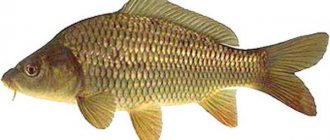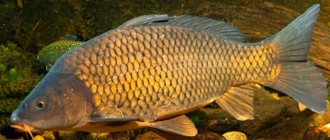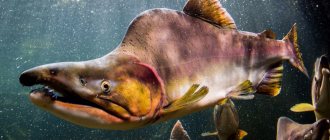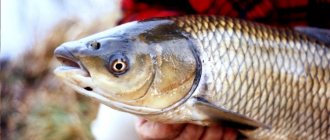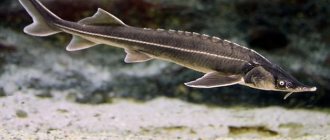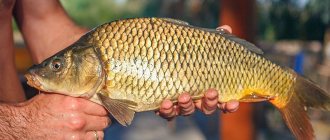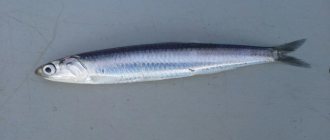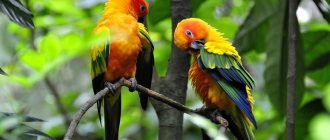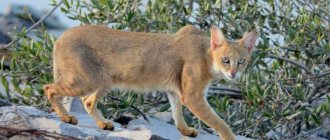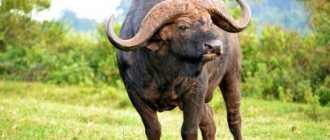5
(5)
Graceful danios, bright rasboras, massive veiltails and about two thousand other species of the cyprinid family inhabit reservoirs and aquariums all over the world. Active, beautiful and playful, they are reverently loved by experienced aquarists and in demand by beginners. Representatives of the family are unpretentious, hardy and easy to reproduce. A flock of cyprinids can be kept in almost any aquarium and easy care, diversity and beauty explain the popularity of the species.
Types of carp
River or wild carp
River carp is a domesticated relative of Carp. The color of the scales on top is dark brown with a golden tint, towards the middle the color acquires a golden-yellow tint, and on the belly the color becomes light. The carp's lips are quite large. There are 4 whiskers next to the lips, two on each side. The fin extends almost the entire length of the back. The eyes are golden in color, the lower fins are gray, and the rear fin is red-brown.
This type of carp lives in large and medium-sized rivers of Russia, Ukraine, middle and southern latitudes of Europe and Asia. They are very sensitive to temperature, so they can only live in rivers that do not flow into the northern seas of Russia. A large number of individuals can be found in the lower reaches of the Volga and Ural waters.
River carp spawns late compared to catfish or crucian carp. In autumn, carp lie on the bottom waiting for ice drift to begin. Until this moment, the carp is inactive. It usually becomes more active in March, in central Russia - closer to mid-April.
This species is the largest of all carp species. According to some data, by old age, carp can reach sizes of up to 1 meter and weigh up to 55 kg.
List of interesting facts:
- weight - up to 15 kg;
- the size of an adult is 35-55 cm;
- lifespan can reach 30 years.
Reproduction and spawning
Carp is a heat-loving fish; to spawn, it waits until the reservoir warms up to 18-20 degrees to a depth of 0.5-1.5 m. Then it chooses a shallow area in reed thickets. Here the female lays portions of eggs, with a total number of up to 1 million future fry, which appear on the 4-7th day. For the first 2-3 days they feed on the yolk of eggs, then they switch to feeding on zooplankton.
How to distinguish a male from a female
Male and female representatives of the species are distinguished only after reaching sexual maturity: males become adults after 2-3 years of life, females - 2 years later. The main difference is the size of the carp.
- Female specimens are 6-7 cm larger than male specimens. For spawning, males need their body to be at least 30 cm, and females - at least 37.
- In addition, the cheeks, back of the head, front fins and gill covers of males are covered with whitish warts.
- In some species, males and females differ in color and anal openings - in the female it is swollen, enlarged, oval in shape and red in color; the female genital opening is compared to a triangular fold.
- Also - by behavior - spawning females become warlike, and the laid eggs are guarded by “men”, becoming aggressive at this time.
Growth rate, average size and weight
First of all, the growth of carp depends on nutrition.
- By six months, the weight of constantly feeding fry already reaches 0.5 kg.
- Fish raised on special food weighs 8-10 kg by the age of 7 and reaches a length of half a meter.
- In a natural reservoir, the food supply is poorer, so wild carp gain such weight only by 14-16 years.
The second condition: the reservoir and its size.
- Large specimens will not grow in a small, unkempt pond.
The third factor is the presence of open water, where there is no crowding. Is it a lake or a river.
- Here you can find fish 150 cm long and weighing more than 25 kg.
How long do carp live?
The lifespan of these fish is directly affected by the environment in which they live. Carps grown artificially acquire better marketable condition after 2-3 years and are subject to harvesting. Wild representatives of the species, living in a natural body of water, live 30 years or more. This is influenced by water temperature and diet with the amount of feed.
Fishermen often come across 2-7 year old carp, weighing 1-6 kg. “Old men”, at the age of 45, are a rarity. The lifespan of decorative species is more than 100 years.
Scaly (common) carp
This type of carp has a massive body. The process of mass growth lasts up to 8 years. In many photographs of fishermen with carp, this species can be immediately distinguished. This is a rather massive fish with large scales.
Loves warmth, prefers quiet, calm waters. It lives in lakes, standing reservoirs and rivers in the southern part of Russia, but can also live in cold rivers, all due to the fact that carp is unpretentious to living conditions and food. A distinctive feature of this type of carp is 2 whiskers in the upper part of the lip. The color of the scales is brown with a yellowish or golden tint; the belly becomes light in color. The color of the scales adapts depending on the body of water it inhabits.
List of interesting facts:
- weight - up to 41 kg. (World record weight 41.45 kg);
- size - length 30-55 cm;
- lifespan - up to 30 years.
The ease of keeping carp, the excellent taste of the meat, making it popular for growing for commercial purposes.
Carp recipes
Carp is baked using foil or grilled, fried, stewed, boiled and pies are baked with it. Meat, cleaned from bones, is suitable for making meatballs, meatballs and cutlets.
Carp fried in a frying pan
- Clean and wash the carcass, cut off all excess and cut into pieces 1-5 cm wide.
- Salt, pepper and mix in flour. Fry in vegetable oil.
- Separately, over medium heat, fry onion half rings. Then pour in the fish pieces, turned over and fried for 5 minutes.
- Cover with a lid and simmer for 7 minutes.
- To serve, sprinkle with dill and lemon juice.
Carp in the oven
- The scales are removed from the fish carcass and washed thoroughly.
- Rub with a mixture of salt and pepper, then stuff with chopped herbs and garlic-sour cream sauce. Thin lemon slices are placed on top.
- Baking time 50-60 minutes. The result is a juicy and tasty dish.
Mirror carp
A type of artificially bred carp. First appeared in European countries. Today it can be found in the rivers of Siberia and southern Russia. This type of carp, like most cyprinids, loves warm waters saturated with oxygen.
Visually, the carp is distinguished by sparse scales that cover only part of the body. The head is fleshy. The color of the scales depends on the body of water it inhabits; the most common color is golden, less often silver, and brown.
Mirror carp is more demanding of its habitat. He needs a lot of oxygen. Prefers to be at shallow depths of the reservoir in warm areas. Fish spawns in May-June. Mirror leads a gregarious lifestyle. Individuals reaching more than 5 kg often live in solitude.
The sizes of individuals reach impressive sizes. On average, the length is from 30 to 100 cm. Weight varies on average from 0.5 to 20 kg.
Description
| Class: | Ray-finned fish |
| Squad: | Carp-like |
| Family: | Carp |
| Genus: | Carps |
| Scientific name: | Cyprinus |
| Homeland: | China and Southeast Asia |
| Habitats: | rivers, lakes, ponds |
| Nutrition: | omnivores |
| Weight: | average 1-5 kg, sometimes up to 50 kg |
| Lifespan: | 2-7 years, some live 50-100 years |
Carp are large freshwater fish. Among them there are predators, herbivores and omnivores. Carp is distinguished from other fish of this family, crucian carp and grass carp, by short antennae on the upper lip. Subspecies also differ from each other.
- River carp constantly have to fight the current to find food, so they are recognized by their elongated and elongated body and smaller size.
- Lakes and ponds are classified as closed reservoirs. The carp here are round in shape, quickly gain weight and are adapted to the lack of oxygen in the water.
naked carp
An artificially bred relative of the common carp. This species may have some scales on its back, near its fins and gills. There are individuals with a complete absence of scales. Loves bodies of water saturated with oxygen and warmth. The growth rate of naked carp is lower than that of mirror and scaly species.
The most common color is light brown. This type has some genetic characteristics that distinguish it from others.
It is more difficult for fish to grind food and obtain nutrients in a body of water due to fewer teeth. The growth rate of fish is noticeably lower than scaly fish. Another feature is a lower number of red blood cells and leukocytes. All this, coupled with the lack of scales, makes the fish more vulnerable to diseases and parasites.
Despite the difficulty of breeding, it is bred on farms in Europe and Russia. Many fishermen strive to catch this particular representative of carp-like fish.
Some interesting facts:
- the weight of individual individuals can exceed 55 kg;
- unlike scaly representatives, there is no ability to restore damaged areas around the fin;
- You can distinguish leather carp by its fin. The fin is two-part, with fewer bones.
Use in cooking
Fleshy fish from fresh water bodies have long been valued for their taste and benefits for the body.
Nutritional value of carp
100 g of this product contains no more than 112 kcal. Therefore, carp meat is an indispensable food for a gentle and dietary diet.
But, it is worth considering that a fried dish increases its energy value by more than 2 times. So those who are losing weight or who do not want to gain weight are advised to eat boiled, stewed or baked carp.
Chemical composition
The meat of river fish, including carp, is rich in minerals necessary for the human body: phosphorus and iron, magnesium, calcium and iodine. And also nutrients, vitamins B, A, C and PP, especially a lot of protein. In addition, carp meat contains proteins and a large amount of Omega-3 and 6 polyunsaturated fatty acids.
Beneficial features
Carp do not feed on carrion; their menu consists only of algae, plants and shellfish, so the meat is clean and healthy and does not cause harm.
With regular consumption of fish dishes, bone tissue is strengthened, mental activity is normalized, and there are no disturbances in the functioning of the heart and blood vessels. There is a strengthening of the immune system, the appearance of strength and energy, as well as a slowdown in aging.
Harm and contraindications
Artificially farmed carp meat is not always beneficial. The reasons for this are different:
- The first thing you should pay attention to is that fish often contains parasites, so it is recommended to boil and fry the meat;
- due to high-calorie additives, harmful fat is added to meat and cholesterol, which is dangerous for humans, accumulates;
- treating fish with antibiotics remaining in the meat weakens human immunity;
- small bones are dangerous for the throat and sometimes injure the esophagus.
- Another danger of carp meat is an allergic reaction in people susceptible to such products.
Taste of carp
Commercially farmed carp are fed a healthy diet that contains fiber, protein and fat. But dietary supplements that accelerate growth, antibiotics, flavorings and food dyes spoil and worsen the taste of fish grown in fish farms.
In wild species, the meat is healthier, has a pleasant sweetish taste, is tender and juicy.
Is the meat bony?
Carp is not considered a very bony fish. The bones are large, but there are few of them. But some people consider the meat of this fish to be bony because of the occasional small bones.
Let's put it this way - when compared with sea fish, carp meat is bony, but among freshwater fish (which carp belongs to) there are few bones in it.
How to choose the right one in the store
When choosing carp or carp, it is recommended to give preference to fresh fish. Indicates freshness:
- difficult separation of bones;
- pulp elasticity;
- protrusion and transparency of the eyes;
- moisture of the scales, on which colorless and slippery mucus remains;
- The color of the gills is bright pink or bright red.
If the carcass is frozen, choose one with an even glaze, which means the freezing was done correctly. Dry freezing does not leave the glaze, but makes the fish look like a smooth stone.
The mirror view is considered the best for choosing carp. When choosing a carcass, they look at its cleanliness; 2-3 bloody marks are allowed.
Koi carp
Representative of the decorative breed of carp. The carp family has many subspecies. Bred from the Amur family by Japanese breeders. It is distinguished by good taste and unpretentiousness in content. Thanks to its color, the carp is a decoration in the ponds of private households and parks in Japan.
The color range of koi carp is varied, the following colors are found: orange, red, blue, black, white, and there may also be a shine to the scales due to a special gene.
Koi carp, as a relative of cyprinids, can reach large sizes - more than 100 cm in length. Koi can be up to 50 years old. It is not recommended to breed koi carp in an aquarium. In cramped aquarium conditions, the fish will not show their full potential in beauty and size.
Koi are relatively easy to keep and breed. The fish is unpretentious and omnivorous. It feeds on food of animal and plant origin. Food should be varied and rich in vitamins. The better the carp feeds, the brighter the body color can be.
Koi love warmth. Fish spawn in early summer. Reaches sexual maturity at 2 - 5 years.
Interesting facts about carp, records
- Because the fish is unpretentious and does not pay attention to water pollution, and its main concern is food, its middle name is water pig.
- Japanese rice farmers were often unable to travel to buy food due to weather conditions. The lack of protein food was compensated for by farmed carp living in reservoirs, from which the plantations were watered.
- A 70-year-old Japanese man takes care of a carp that he inherited. The age of the fish is 105 years. The owner is offered large sums, but he categorically refuses to sell the pet.
Amursky
A herbivorous relative of the carp, it belongs to the class of ray-finned fish. Also called grass cupid. Amur carp comes from East Asian reservoirs. It was present in the lower reaches of the Amur, Chinese and Vietnamese rivers. Today it can be found in the waters of Europe, Sakhalin, and North America.
Amur carp loves water bodies with rich vegetation. This species adapts to low temperatures down to 0 C. Comfortable water for carp is about 25 - 30 degrees. Leads a gregarious lifestyle. It leaves for the winter when the water temperature does not exceed 8-10 C. In winter it stops searching for food and falls asleep, gathering in large flocks in bottom holes and depressions. During hibernation, a special mucus is produced that warms the fish in a state of suspended animation.
Interesting Facts:
- It is a water bottom cleaner and eats a lot of grass and algae from the bottom. Can eat up to 3 kg of grass per day;
- meat and liver are rich in vitamins. Dietary meat is very useful for those who eat healthy.
General information
The carp family has a universal distinctive feature - the absence of teeth on the jaws. The teeth are located inside the pharynx on the pharyngeal bones. The process of absorption of food involves capturing food and pushing it inside, where grinding occurs. The oral cavity is mobile, the lips are flat and fleshy. Many individuals have one pair of antennae above the upper lip (in addition to the eight-whiskered gudgeon, it has 4). The swim bladder is very strong, contains 2, rarely 3 segments. The body is covered with large scales or completely naked, which is not so common. During spawning, the female lays eggs on flat stones or algae leaves. Eggs traditionally have a viscous, sticky structure with rare exceptions. Let's say that grass carp's future offspring drifts in a stream of water. The carp family is a commercial fish; even small species are popular among breeders and fishermen. About half of the famous species are bred in unnatural reservoirs for subsequent sale . These may include:
- carp;
- rudd;
- vobla;
- silver carp, etc.
Barbs are aquarium fish from the carp family. Decorative aquarium fish are no less popular. The history of their breeding lasts for more than a dozen years. It is known that the first mentions date back to the 1st century of our era. The selection was first carried out by Japanese experts, and after that by Chinese experts. The list of aquarium breeds includes:
- goldfish;
- brachydanio;
The sizes of natural inhabitants range from 6 to 300 cm in length. This spread is characterized by the diversity of carp fish species. But huge representatives (more than 80 cm) are not so common. Medium-sized species are especially common. The sizes mainly depend on the continent of habitat. Thus, North America is inhabited by small representatives, while in central Eurasia, huge fish with a length of about 20–150 cm dominate. The color can be different, clear greenish and golden shades are especially common. But selective species bred unnaturally amaze with their variety of colors. Colored representatives of the natural environment are found in the tropical zone.
Linear
The most insignificant and genetically unstable variety of cyprinids. Very similar to the naked and mirror look. Distinguished by one row of large scales along the lateral line.
Linear carp have low growth potential. There are few red cells in the blood; the fish needs a body of water with high oxygen levels. Weakly resists diseases and parasites. Muscle mass and skeleton develop more slowly than in other species. It has a small number of rakers and gill teeth.
Linear carp are inactive. If there is enough food and oxygen in the pond, nutrients are stored mainly in fatty form. This species is bred in private ponds exclusively for sport fishing.
Family Features
The family's attorneys are united by the presence of the Weber's aggregate and pharyngeal teeth. They are located on the lower pharyngeal bone in one, two or even three rows. Cyprinids swallow food with their mouths, and grinding occurs closer to the pharynx. For this reason, fish have rather fleshy lips. The fish are also characterized by a huge swim bladder and a specific digestive tract. The final one is not divided into compartments, but has the form of a tube. In predators it can achieve the length of carp, and in herbivores it can exceed the body size by more than 2 times. The length depends on the diet of the fish.
Romanian
Romanian carp was bred in Romania based on crossing Ukrainian and Hungarian carp. The body of this type is quite thick. Length reaches 100 cm. Weight up to 12-16 kg. Rare representatives gain weight of 20 kg.
The body is yellow with a green tint, the back is dark green with a blue tint. The belly of the fish is light in color. Color can vary greatly depending on living conditions.
Like many types of cyprinids, they love warm water. Undemanding to living conditions. They can tolerate a lack of oxygen and food. Egg laying occurs in May - June at a water temperature of 18-20 C.
Description and characteristics of fish of the carp family
Cyprinidae are fish from the carp family. There are about two thousand species. Represented by marine, freshwater and aquarium inhabitants. Within the family there are more than 250 genera, which are combined into 9 subfamilies.
The habitat of cyprinids is huge.
They are found all over the world, but their main habitat is Asia and Europe.
The body of the fish is covered with scales, the head is bare. The edge of the upper jaw is formed by the premaxillary bones, the belly is rounded without ossification. There are no adipose fins.
Cyprinidae species differ from each other in color, habits, food preferences and lifestyle. The size of the fish can vary greatly depending on the species. Small representatives of the family grow up to 6-7 cm, while some species can reach 1.5-2 m.
The largest carp fish is considered to be the giant barbel, whose length reaches 3 meters. He lives in Thailand and Vietnam.
The giant barbel is the largest representative of cyprinids
The body color of cyprinids can be very diverse. The most popular of them:
- golden;
- silver;
- dirty green.
Popular representatives
White amur
Grass carp is a herbivorous member of the carp family. Her favorite place is water overgrown with grass and reeds. The fish is a cleaner and can process up to 3 kg of grass per day. In Russia, it mainly lives in the waters of the Volga and Oka. Also found in the Amur and Yenisei rivers, and in the rivers of China.
Cupid breeds only in summer. The fish reaches sexual maturity at the age of 8-10 years. Fish spawn in clean water with fast currents. Prefers to lay eggs on hard bottom in shallow water.
List of distinctive features of White Cupid:
- elongated, laterally flattened body;
- short fins, large fins;
- large scales. The belly color is white. The back has a grey-ash color. The sides are silver with a yellow tint. The scales may have a dark olive tint.
Silver carp
A freshwater species of cyprinids, it belongs to the class of ray-finned fish. Silver carp has silver-colored scales. The length of the fish reaches 60 cm and weight 20 - 30 kg.
Initially lived in China and in the Amur River basin. During Soviet times it was introduced into many rivers. Today it is found in the Dniester, Volga, Kuban, Terek, Dnieper, and Aral Sea.
Silver carp meat is excellent as a dietary food. Contains many useful microelements, and low calorie content - 86 Kcal. For diseases of the cardiovascular system, it is useful to include meat in the diet. Thanks to the beneficial properties of meat, cholesterol and sugar are reduced and blood pressure is normalized. The meat has good taste, tenderness and juiciness; it can be boiled, fried, baked.
Vobla
Freshwater fish of the carp family. Inhabits the Caspian Sea and large rivers of its basin. Roach specimens are small in size. The length of an adult is up to 30 cm. Weight is about 200 grams. It belongs to the roach genus, so distinguishing roach from roach is problematic. It has flattened sides covered with silvery scales.
Vobla's diet depends on its habitat. They feed mainly on mollusks, crustaceans, worms, insects, and larvae. Fish spawn in spring at the end of April. The fish reaches sexual maturity at the age of 2 years.
Vobla is a commercial species. Gained the greatest popularity during the Soviet era. In conditions of the economic crisis, fish were sold en masse along with caviar and cervelat.
Vobla meat has a high protein content. The calorie content of meat is low - 95 Kcal. Contains B vitamins. Meat is indicated for the prevention of cardiovascular diseases, as well as for people on a diet. Fish is not popular in home cooking. They prefer smoking and drying.
Chub
The freshwater species of carp is a predator. Habitat in Europe and Asia Minor. In Russia it lives in rivers of the European part. Prefers strong currents, hard or sandy bottom. It can also live in standing waters.
They lead a gregarious lifestyle. Larger individuals live in groups of several together. They can feed on small fish - minnows, bleak. It also feeds on a variety of animals:
- frogs;
- insects;
- shellfish;
- worms
Chub spawn when the water temperature reaches 17 C, usually from May to June. Females lay up to 150-200 thousand eggs. The fish reaches sexual maturity at 3 years of age, when the weight becomes at least 200 grams.
Chub meat is quite bony. Balyk is made from it, it is salted, dried, and smoked. You can make a delicious fish soup from chub.
Asp
A predatory species of carp. Habitat: rivers of Eastern Europe up to the Rhine. In Russia it is found in the basins of the Baltic, North and Black Seas.
The asp has a long body. The sides are grayish with a silver tint. The fins are gray in color, the ends of the fin are edged with a dark stripe. The asp's lips, like those of many carp species, are large and fleshy. The upper lip is shorter than the lower lip, this allows it to capture and hold prey.
The average weight of Zherekh is about 1.5 - 3 kg. The length reaches an average of 35-50 cm. Rare representatives grow up to 90 cm in length with a weight of up to 8 kg.
The predator leads a solitary lifestyle. The fish has no teeth so it feeds on small fish, worms, and insects. The asp crashes into the flock, striking hard with its tail, thereby stunning the prey. Can gather in flocks and hunt for food together.
Despite the low population, Asp is a valuable commercial fish. Asp's meat is tasty and tender, rather bony. In stores you can find fresh frozen meat, dried and smoked. Zherekh caviar is prized; it has an amber color. Caviar has a large amount of nutrients and beneficial substances for humans.
Gudgeon
Fish from the carp family. To date, 14 species of minnows are known. The most common is the common gudgeon. The fish is distributed throughout the basin of the North, Baltic, and White Seas. It is found in the Terek and Volga rivers, as well as in the North-Eastern regions of Europe.
Gudgeon is food for predators. The size of the gudgeon reaches 20 cm in length, with a weight of 200 grams. The fish feeds on foreign eggs, larvae, and small shells.
Fish spawn in April. It becomes sexually mature when it reaches 8 cm in length. Females lay eggs in a rocky-sandy bottom.
The meat is very tasty, tender with a sweetish aftertaste. Rich in nutrients. There are few bones on the sides, which is convenient during cooking. Gudgeons are used to make delicious fish soup; you can fry meat or make sauce.
Verkhovka
Verkhovka is one of the smallest fish of the carp family. Found in the rivers of the Rhine, Volga, rivers of the Caucasus, and Belarus. Lives in ponds, lakes, quarries. The fish leads a sedentary lifestyle, avoids currents, and prefers muddy bottoms.
The size of the fish is 8-9 cm. Lives up to 5 years. Weight up to 7 grams. Eats plankton and fish larvae. During the day it floats on the surface of the water, at night it sinks to the bottom. Spawns at the end of May - June, the second time in July. Becomes sexually mature at 2 years of age.
It has no commercial value due to its small size. The number of fish is quite high in the ponds. It is a food competitor to other commercial fish, eating zooplankton, so the presence of this fish in fish ponds is undesirable.
Gustera
A relatively small carp fish. It is distinguished by a tall body and large gray scales on the sides. The back is bluish-gray in color. The eyes are large relative to the size of the body. Externally similar to bream. It is distinguished by the presence of double-row pharyngeal teeth.
Lives in fresh water bodies of Europe. And also in the basins of the North, Baltic, Azov, Black and Caspian seas. Gustera does not like currents, prefers quiet, calm waters. Leads a gregarious lifestyle.
The fish lives no more than 15 years. Reaches a length of 35 cm and a body weight of about 1.2 kg. It feeds depending on the body of water. It feeds on larvae, mollusks, algae, and detritus.
The high bone density and small size of the fish do not make it popular in cooking. They prefer to dry and salt fish.
Barbus
Ray-finned fish from the carp family. Widely distributed in the aquarium hobby. Habitat mainly in the tropical part of the planet: southern Asia, India, Sri Lanka, found in equatorial Africa. Some species can be found in America, Cambodia, Australia, and Singapore.
The fish is unpretentious and small in size. Has a bright natural color. Depending on the species, fish may have one or more colors. Spots, longitudinal and transverse stripes may also be present.
The sizes of the fish vary from 5 to 35 cm. Life expectancy is 6-7 years. The barb has an elongated body and a pointed head. Often have four transverse stripes. The fins and tail are bright red. The lower fins are two-part.
Barbus leads a gregarious, active lifestyle and is very mobile. It is very popular in the aquarium hobby.
Features:
- unpretentious in maintenance and breeding;
- high activity of the fish poses a danger to the large fins of slower fish;
- They are schooling and actively interact with other fish.
Danio
A number of small ray-finned fish. Some of the breeds are widely used for aquarium breeding. Natural habitat is the waters of Southeast Asia. They prefer standing waters.
Danios have different colors depending on the species. There are many artificially bred decorative forms. A distinctive feature is the presence of antennae near the mouth.
They lead a gregarious lifestyle. The fish is very peaceful and does not like loneliness. Tolerates well in proximity to other non-aggressive fish species. They spend a lot of time in constant motion.
The fish is unpretentious in keeping. Therefore, it is recommended for those who want to try breeding fish. The fish feeds from the surface of the water and loves warm water and wide swimming areas.
Necessary conditions for breeding Danio:
- absence of large, slow and aggressive fish;
- feeding primarily from the surface;
- availability of large space for swimming;
- keeping in flocks of 10 - 15 individuals;
- the presence of open areas of the aquarium with good lighting.
Labeo
Fish of the carp family. Refers to decorative species. Natural water habitat of Southeast Asia.
In the wild they reach 18-30 cm. In an aquarium it is smaller - from 10 to 20 cm. Life expectancy is 5 - 6 years. It feeds on plant foods and algae. The appearance resembles a miniature shark. The main distinguishing characteristic is its color: dark body and bright red tail.
Breeding Labeo in an aquarium is quite difficult. Doesn't get along well with some species. Leads a solitary lifestyle. Can attack fish. It is not recommended to keep fish of the same color in the same aquarium; they will fight. Feeding with algae and plants is required. Loves dim light and wide open space in the aquarium.
There are practically no gender differences. Mature females have a more rounded abdomen. Not used for fishing. The species is listed in the Red Book.
Maintenance and care in the aquarium
The carp family includes popular fish that easily adapt to the proposed conditions. But for a more comfortable stay for your pets and their successful reproduction, it is worth observing some subtleties:
Aquarium. The size depends on the number and size of individuals in the flock. It should be spacious enough and have a standard set of equipment (thermostat, compressor and filter). Most species may need a heater.
Water parameters. The carp family thrives in warm water. An endemic of the tropics and subtropics, when kept at home, prefers a temperature of 24-28 °C. Water hardness and lighting are not particularly significant parameters. These unpretentious aquarium fish sometimes amaze with their vitality and will adapt to the proposed circumstances with surprising ease.
Soil and decor. Both sand and pebbles of any size can be used as soil. When choosing the color of the soil, you should choose a color that contrasts with the color of the inhabitants for a more impressive appearance of the flock. You can decorate with artificial castles, large stones, natural branches, and driftwood. All this will decorate the “jar” and serve as a shelter for fry or in case of conflicts.
Plants. You can plant a lot of different ones, but at the same time leave space for the free movement of the flock. Unpretentious aquarium fish will not spoil leaves and roots if they have a sufficient and varied diet. It is possible to use above-water and artificial plants.
Nutrition. The carp family is also unpretentious in nutrition and almost omnivorous. They accept live, dry and frozen food. They spend most of their time in the middle and upper layers of the aquarium, so they enjoy eating flakes and granules with pleasure. The diet must include plant foods.
Some species are prone to gluttony and feeding should be dosed. With proper, balanced nutrition, freshwater fish will delight you with their natural behavior and healthy appearance.
crucian carp
Crucian carp is a common inhabitant of fresh water bodies. Distinguished by its low demands on water quality and its oxygen saturation, it is a valuable species for breeding in small ponds. There are 2 varieties: gold and silver, differing in the color of the scales and minor morphological features. Capable of creating interspecific hybrids. Typically, silver crucian carp is somewhat larger than its golden relative.
This fish is characterized by rapid reproduction, so it is necessary to strictly control the number of individuals in the reservoir - an increase in the population with an insufficient food supply leads to the grinding of fish. Under natural conditions, it lives for about 10–12 years, reaching a weight of up to 4.5 kg.
Preferring the same types of food as carp, crucian carp poses serious food competition to the latter. Taking this into account, simultaneous breeding of crucian carp and crucian carp in the same reservoir is not recommended.
The goldfish, known and loved by many aquarists, is a representative of the crucian carp. It was bred quite a long time ago - according to some sources, more than 1000 years ago in China by purposefully fixing unusual coloring and certain external characteristics at the genetic level. In the 12th century, goldfish were brought from China to Europe, where they quickly gained enormous popularity.
Siberia is rich in fish...
Siberia represents one large box of skills about the history and wealth of the earth's bowels. One of the greatest riches of the Siberian region are lakes and rivers known throughout the country, surprising the viewer with their beauty and purity of water. Real expanse awaits lovers of fishing on the banks of rivers and lakes of Siberian land. Fishing tourism itself on Siberian soil can be described in one word: “wild”. And the term “wild” refers not only to the presence or absence of places of residence, and the unbreakable war with the mosquitoes present here, but this type of tourism does not have an obvious colorful negative connotation.
First of all, it should be noted that each Siberia surprises with the variety of climatic conditions and the abundant multi-colored beauty of nature. Siberian regions are often compared in size to entire European countries. Depending on its climatic and natural conditions, certain types of fish live throughout the entire region of Siberia. Since the beginning of the 70s, at the direction of the authorities, a number of fish were “introduced” into the Siberian rivers, which the local population only knew by hearsay:
- Carp.
- Silver carp.
- Zander.
- Carp.
Muksun habitats
Muksun is a freshwater fish of the north. It’s true that she lives in the ocean, but she doesn’t swim far from the shore. The love for unsalted water determines those places where delicious fish are found. It lives in the Arctic Ocean, sticking to desalinated areas near the confluence of rivers. Selects the largest Siberian rivers: Lena, Yenisei, Ob, Irtysh, Kolyma, Kara. It can also live in fresh northern lakes. The lake variety has a golden hue.
Like many northern inhabitants, muksun has a lot of fat. In the ocean, muksun accumulates fat and strength, and swims into rivers to spawn. Semi-anadromous fish migrate far upstream of the rivers in whose deltas they live. The dear whitefish begin to move to spawn in the spring, when the ice has completely disappeared from the rivers. But it reaches the spawning grounds only in the fall. Spawning begins in September, when the first ice appears on the northern rivers. Spawning ends in November, when the water temperature drops sharply. After spawning, the fish return to their usual habitats to fatten and accumulate strength. The fish lays eggs in places where rivers ripple, and the bottom is made of pebbles. During one spawning, the female lays from 40 to 60 thousand eggs. The number of eggs depends on the size of the animal. Muksun does not spawn every year, but does so once every 4-5 years. The eggs laid on the bottom mature for about six months. The fry hatch in mid-spring and migrate down the river.
White amur
Another vegetarian of the carp family. Feeding the vegetation of a reservoir leads to its clearing of overgrowth, for example, it successfully fights reeds. It is of great interest in fish farming due to its fairly rapid growth and valuable meat. Acclimatized almost everywhere. Reaches over a meter in length and up to 40 kg of live weight.
With a sufficient food supply, it does not compete with carp and other fish with a similar diet. It is worth considering that if there is a shortage of natural food, it can also feed on mixed feed.
It reaches sexual maturity at 6–9 years, but when reared in ponds it is not capable of independent reproduction. On the one hand, this entails certain difficulties in artificially fertilizing eggs and additionally stocking the reservoir with grown-up fry, on the other hand, it allows for fairly accurate control of the number of this fish in the pond.
When planning the development of a fishery, it is necessary to study as fully as possible the information related specifically to the carp family, since cyprinids represent the majority of commercial freshwater fish. The diversity of cyprinids makes it possible to successfully combine different species in one reservoir, using their biological characteristics.
